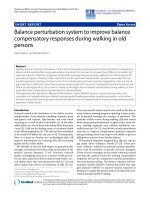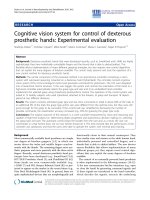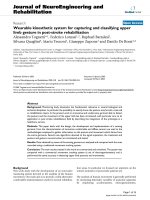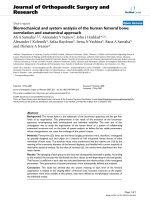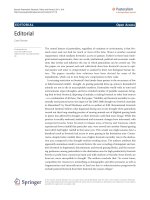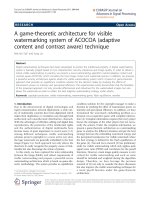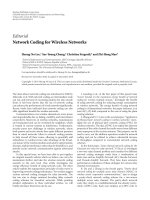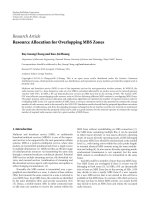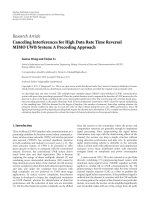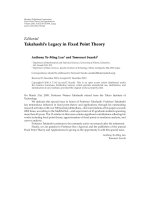Báo cáo hóa học: " Editorial Operating System Support for Embedded Real-Time Applications" potx
Bạn đang xem bản rút gọn của tài liệu. Xem và tải ngay bản đầy đủ của tài liệu tại đây (422.92 KB, 2 trang )
Hindawi Publishing Corporation
EURASIP Journal on Embedded Systems
Volume 2008, Article ID 502768, 2 pages
doi:10.1155/2008/502768
Editorial
Operating System Support for Embedded
Real-Time Applications
Alfons Crespo,
1
Ismael Ripoll,
1
Michael Gonz
´
alez-Harbour,
2
and Giuseppe Lipari
3
1
Depar t ament d’Informatica de Sistems i Computadors, Universidad Polit
´
ecnica de Val
`
encia, 46022 Valenc ia, Spain
2
Universidad de Cantabria, 39005 Santander, Spain
3
Scuola Superiore Santa’Anna, 335612 Pisa, Italy
Correspondence should be addressed to Alfons Crespo,
Received 18 February 2008; Accepted 18 February 2008
Copyright © 2008 Alfons Crespo et al. This is an open access article distributed under the Creative Commons Attribution License,
which permits unrestricted use, distribution, and reproduction in any medium, provided the original work is properly cited.
The rapid progress in processor and sensor technology com-
bined with the expanding diversity of application fields is
placing enormous demands on the facilities that an embed-
ded operating system must provide.
Embedded systems can be defined as computing systems
with tightly coupled hardware and software that are designed
to p erform a dedicated function. The word embedded re-
flects the fac t that these systems are usually an integr al part
of a larger system.
We can find a large variety of applications where embed-
ded systems play an important role, from small stand-alone
systems, like a network router, to complex embedded systems
supporting several operating execution environments as we
can find in avionic applications.
This variety of applications also implies that the prop-
erties, platforms, and techniques on which embedded sys-
tems are based can be ver y different. The hardware needs
can sometimes be achieved with the use of general purp ose
processors, but in many systems specific processors are re-
quired, for instance, specific DSP devices to perform fast sig-
nal processing. Memory management capabilities are neces-
sary in some systems to provide memory protection and vir-
tual memory. Special purpose interfaces are also needed to
support a variety of external peripheral devices, energy con-
sumption control, and so on.
Nowadays, the use of processor-based devices has in-
creased dramatically for most of our activities, both profes-
sional and leisure. Mobile phones and PDAs are used exten-
sively. Consumer electronics (set-top boxes, TVs, DVD play-
ers, etc.) have incorporated microprocessors as a core system
component, instead of using specific hardware. This trend is
expected to grow exponentially in the near future.
Embedded applications have some common features
such as the following.
(i) Limited resources. They are often strong limitations
regarding available resources. Mainly due to cost and
size constraints related to mass production and strong
industrial competition, the system resources as CPU,
memory, devices have been designed to meet these re-
quirements. As a result of these limitations, the system
hastodealwithanefficient use of the computational
resources.
(ii) Real-time application requirements. Some of the ap-
plications to be run in these devices have temporal re-
quirements. These applications are related with pro-
cess control, multimedia processing, instrumentation,
and so on, where the system has to act within a speci-
fied interval.
(iii) Embedded control systems. Most of the embedded sys-
tems perform control activities involving input data
acquisition (sensing) and output delivery (actuation).
Deterministic communications are also another im-
portant issue.
(iv) Quality of service. An efficient use of the system re-
sources is a must in embedded systems. Feedback-
based approaches are being used to adjust the per for-
mance or quality of service of the applications as a
function of the available resources.
The challenge is how to implement applications that
can execute efficiently on limited resource and that meet
nonfunctional requirements such as timeliness, robustness,
dependability, performance, and so on.
2 EURASIP Journal on Embedded Systems
Moreover, applications on embedded systems include
more and more functionalities in order to cope with the
needs of the users in home environments, industry, leisure
activities, vehicles, avionics, instrumentation, and so on. To
offer services for these applications, a considerable effort has
been made in research and development on innovative real-
time operating systems architectures and services. Designers
and developers of real-time operating systems have to con-
sider many challenges arising from two opposite axes: effi-
cient resource usage (processor, memory, energy, network
bandwidth, etc.) and dynamic configuration and adapta-
tion (component-based development and deployment, flexi-
ble scheduling, communications, etc.).
On the other hand, open-source operating system devel-
opment has been recognized as a consolidated way to share
experiences and developments in order to improve the qual-
ity and the reusability of the products. Currently, there are
several distributions for embedded systems based on Linux
and other open source developments.
This special issue focuses on new results of research work
and development in the field of real-time operating systems
for embedded applications with special emphasis on open
source developments.
From the real-time operating system point of view, there
are several topics that can be considered very relevant in the
near future, illustrated as follows.
Partitioned systems
The development of embedded applications is entering into
a new domain with the availability of new high-speed proces-
sors and low cost on-chip memory. As a result of these new
developments in hardware, there is an interest in enabling
multiple applications to share a s ingle processor and mem-
ory. To facilitate such a model the execution time and mem-
ory space of each application must be protected from other
applications in the system. Partitioning operating systems
represents the future of secure systems. They have evolved to
fulfill security and avionics requirements where predictabil-
ity is extremely important. In avionics systems, for instance,
running interrupts other than the system clock needed for
cycling the partitions is discouraged. In a partitioning oper-
ating system, memory (and possibly CPU-time as well) is di-
vided among statically allocated partitions in a fixed manner.
The idea is to take a processor and make it appear as if there
were several processors, thus completely isolating the subsys-
tems. Within each partition, there may be multiple threads
or processes, or both, if the operating system supports them.
How these threads are scheduled depends on the implemen-
tation of the OS.
Innovative techniques
Innovative techniques in scheduling are needed to provide
support for adjusting the load to the system needs, manag-
ing the dynamic allocation of memory under temporal and
spatial constraints, manag ing energy to allow trading perfor-
mance for reduced energy consumption in combination with
the time constraints, providing fault-tolerance to deal with
failure management and recovery, and so on.
Security
Embedded systems are getting more and more complex, dy-
namic, and open, while interacting with a progressively more
demanding and heterogeneous environment. As a conse-
quence, the reliability and security of these systems have be-
come major concerns. An increasing number of external se-
curity attacks as well as design weaknesses in operating sys-
tems have resulted in large economic damages, which re-
sults in difficulties to attain user acceptance and getting ac-
cepted by the market. Consequently, there is a growing re-
quest from stakeholders in embedded systems to make avail-
able execution platforms which address both integrity and
security concerns. For instance, it is important to avoid de-
nial of service issues provoked by resource shortage (e.g.,
memory, CPU), while from an integrity viewpoint it is im-
portant to ensure availability of resources. It is also impor-
tant to prevent malicious access to data created by another
application.
Other aspects
Other aspects such as mutiprocessor system support, power-
aware operating systems, real-time communications will
have a relevant role in the next generation of embedded sys-
tems.
In this issue, several papers offer the particular vision of
these issues. The first paper provides an approach of par-
titioned systems based on the L4 microkernel, whereas the
second paper proposes a multiprocessor embedded system
based on ASMP-Linux. The third and fourth papers deal with
resource and reconfiguration management. The last two pa-
pers present application environments where the real-time
operating systems present specific services to fulfill the re-
quirements of these applications.
Alfons Crespo
Ismael Ripoll
Michael Gonz
´
alez-Harbour
Giuseppe Lipari
